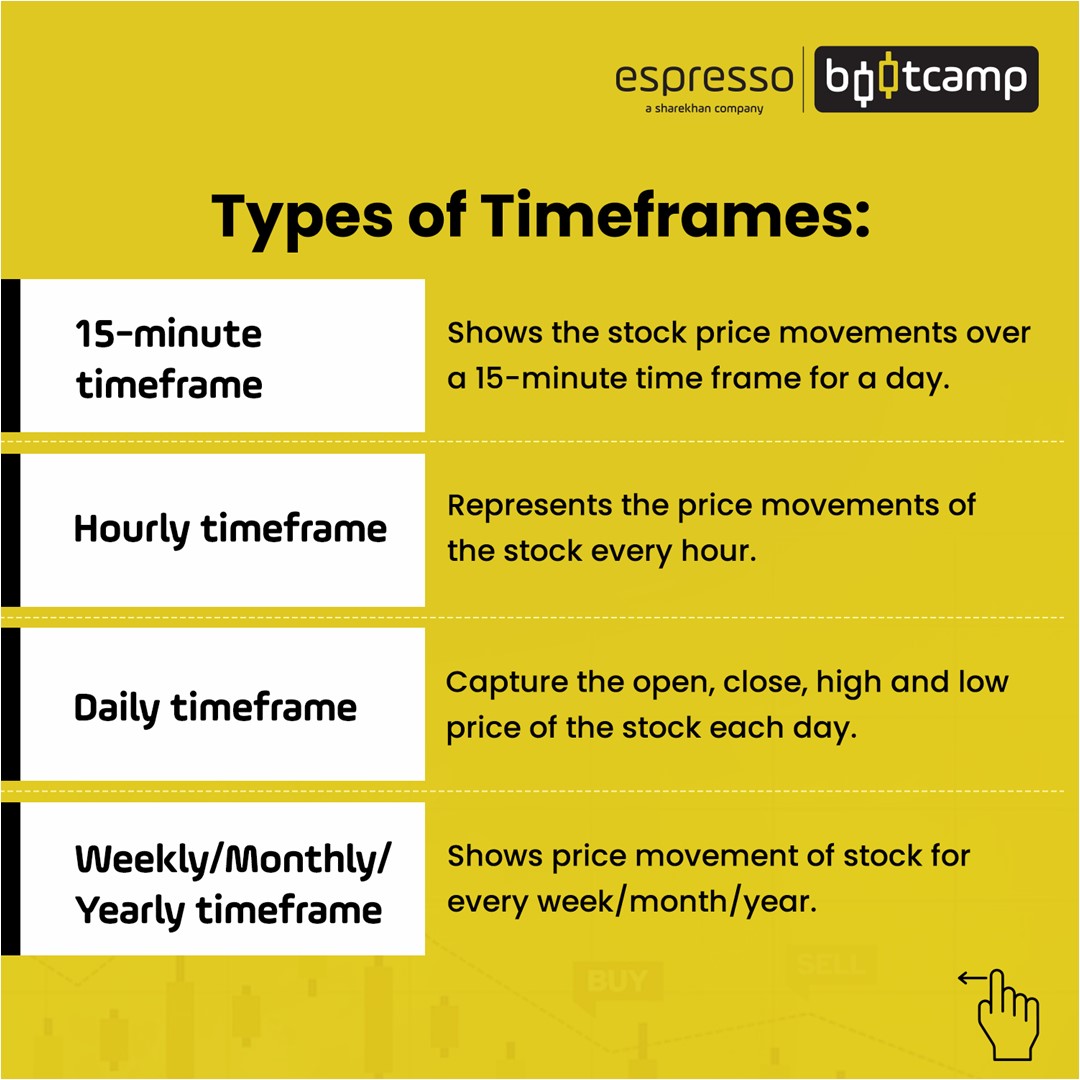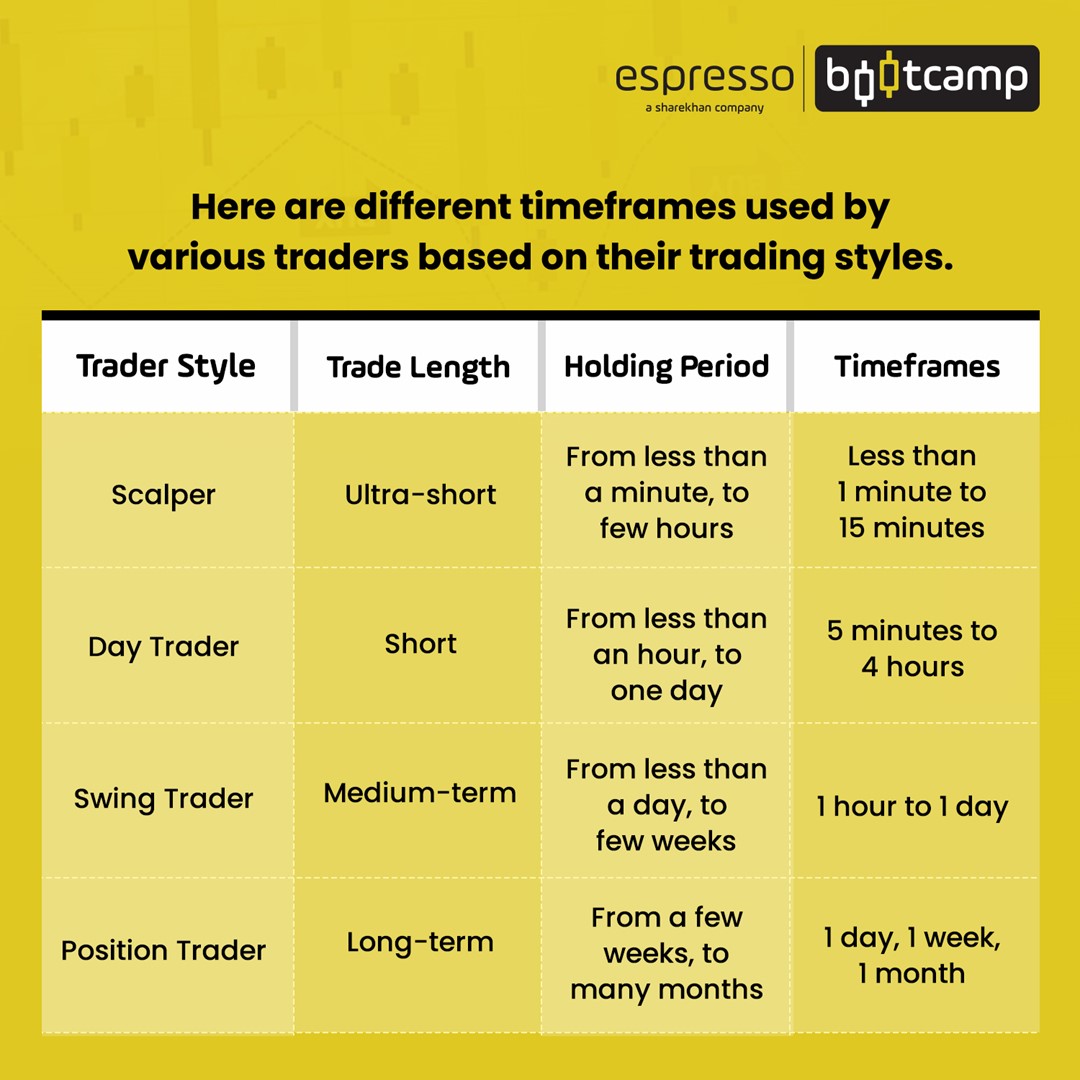Like so many other things in life, timing is of utmost importance while trading in stock markets. Any trade, which could have given substantial returns, can turn red in the blink of an eye if we don’t exit at the right time. Similarly, the right entry point makes can make a huge difference in determining our success.
The sole purpose of traders is to make money in the stock markets, and maximum money is made when the trader is able to ride the complete trend for the longest possible time. Therefore, the important question here is to identify how long the trend will last to gain maximum advantage from the wave and this will be answered if we have an understanding of the different types of timeframes that a trader can use.
What is timeframe in technical analysis?
Typically, a timeframe is the duration for which the trend might last in a particular asset, which a trader can identify and use to make money.
Remember:
- Different timeframes only change the information they provide to the trader
- They do not change the underlying macro and micro factors that impact the movement of the markets or the securities
- They merely act as mediums to present the same information in different ways with a change in the time period
Types of timeframes
Timeframes are usually categorised into three types depending on the duration for which you want to trade in a specific asset. They are:
- Primary
- Intermediate
- Short term
It is important to note that the market can exist in multiple timeframes at any given point in time.
As highlighted earlier, different timeframes depict different information about the markets. An uptrend in the primary timeframe does not guarantee the stock will necessarily be in an uptrend in the short-term timeframe. Thus, it is important for a trader to keep an eye on all timeframes to get the desired results, even though he might be focusing only on one specific timeframe.
When it comes to time frame in trading, a trader can conduct multiple time frame analyses and select the appropriate timeframe based on their trading style, ranging from a minute to hours, weeks, months, and even years.
Choosing a timeframe
As a thumb rule, it has been observed that a longer timeframe predicts:



- An underlying trend in a much stronger manner
- Helps gauge what is happening with the security over a period of time
- How it may move forward
Choosing a shorter timeframe is necessary if a trader has shorter trading horizons. However, a concise/compact timeframe usually results in a lot of noise which can result in an error of judgement.
Therefore, it is always advisable:
- To identify the underlying primary trend with the help of longer timeframes
- Drill down shorter timeframes to identify the intermediate and short-term trends
Depending on trading style, a trader can choose an ideal timeframe.
A swing trader with a short to medium time horizon (from a few days to a few weeks) might lay more emphasis on daily charts to arrive at a trading decision.
Remember: Use hourly charts to identify the short-term trend, and also use weekly charts to ascertain the primary trend, which will help with calculated and risk-averse decisions.
Weekly charts might be more helpful for a positional trader.
Remember: Use monthly charts to gauge the primary trend while using daily charts to decide actual entry and exit points.
A day trader can rely on a 10 or 15-minute chart to decide on the trade. Also Read about What are Charts and Their Types?
Remember: Use a tick chart/5-minute chart to identify the short-term trend and a 60-minute chart for the primary trend
Scalpers, who undertake a trade only for a very short duration, prefer to use timeframes that range from 1 minute to 5 minutes.
Remember: Some scalpers start with a 5-minute timeframe to enter the trade and then move down to shorter timeframes to decde on their exit.
Rules to choosing timeframes
- There is no fixed rule for choosing timeframes
- Each individual trader picks timeframes depending on their styles and goals
- Traders should always check and complement their chosen timeframe by carefully confirming their hypothesis/logic in other timeframes as well
Ideally:
- Start with a longer-term timeframe/chart to identify the underlying primary trend
- Move to an intermediate time frame/chart to confirm the possibility of a trade
- Then move to a much shorter timeframe to arrive at the exact entry and exit points
Points to remember
- Timeframes do not change the macros or the underlying primary trend\
- They depict the same information in different ways
- Shorter timeframes may be considered as building blocks for longer ones
- Timeframes can be of any duration - can range from minutes to hours to days, weeks, months or even years
- Increasing the timeframe will reduce details/noise, which may be worthwhile, especially when volumes are high
- Conversely, when volumes are low, a shorter timeframe will help provide more details needed to execute the trade
- It is always wise to use multiple timeframes at a time and not depend on a single timeframe to get a better understanding of stock trading.
 0
|
0
|
 0
0
 Modules
Modules

 Watch
Watch 
